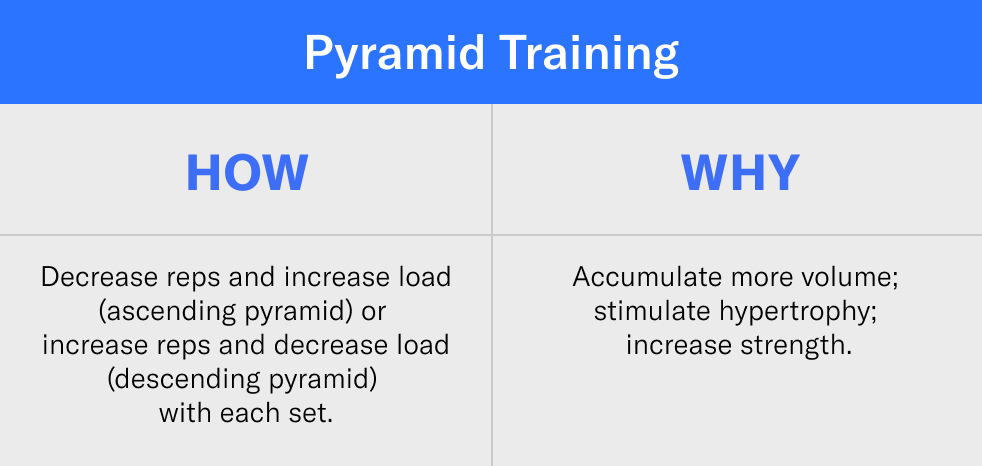Mix Up Your Reps and Get Big Results with Pyramid Training
Pyramid training adds variety to your workout while stimulating strength gains and muscle growth.

If every time you do a strength-training workout you default to “3 sets of 10,” it’s time to shake up your routine. There’s nothing wrong with a straightforward rep scheme—3×10 is a go-to classic because it generally works, especially if you increase your weight over time. But doing the same workout again and again can be boring, and you may be missing out on some of the unique benefits of other types of training—such as pyramid training.
Pyramid training is the antidote to lifting tedium because it requires you to constantly switch up either your load or rep scheme. Yet, even though the variables of your training program are always shifting, you still accumulate enough volume to build strength and muscle mass. And because there are multiple approaches to pyramid training, it’s useful for beginners who are still mastering proper form as well as more advanced lifters who want to focus on developing maximal strength.
What Is Pyramid Training in Strength Training?
Most everyday strength training workouts use straight sets, such as the trusty “3 sets of 10” rep scheme in which each set, including the reps, load, and rest period, is identical.
Pyramid training is different in that it’s progressive: You either increase the load or the reps as you move through your sets. If resistance gets heavier with each set, you simultaneously reduce the number of reps you perform. If you go up in reps, you lift less weight.
If you think of your workout in terms of a pyramid, the set with the highest number of reps is the base.

What Are the Different Types of Pyramid Training?
Generally speaking, all pyramid training involves the manipulation of load in relation to reps, but there are a few different ways you can approach this style of lifting.
Ascending Pyramid Training
Also known as standard pyramid training, ascending pyramid workouts involve starting with a light or moderate weight and, with each set, increasing your load as you decrease your reps.
For example, you could start an ascending pyramid squat scheme with 10 reps at 50 pounds with 60 seconds of rest. Then, on your next set, you might increase the weight by 10 pounds (the exact numbers depend on multiple factors, including your goals, experience, and maximal strength) and decrease your reps to eight, keeping the rest periods the same. On the next set, you’d bump up the weight to 70 pounds and perform six reps. The exact number of reps you do (you could stop at six or work your way up to a single rep) depends on your individualized training plan. If you wanted to finish with a 100-pound single rep, here’s what your ascending pyramid could look like:
| Set | Weight | Reps |
| 1 | 50 | 10 |
| 2 | 60 | 8 |
| 3 | 70 | 6 |
| 4 | 80 | 4 |
| 5 | 90 | 2 |
| 6 | 100 | 1 |
Descending (or Reverse) Pyramid Training
A descending pyramid, or a reverse pyramid, works the opposite way. Using this rep scheme, you start with your heaviest weight for the session and reduce the load as you increase reps. For example, you could start with a 100-pound single rep, then shed 10 pounds with each subsequent set, simultaneously upping your reps. This workout could look something like this:
| Set | Weight | Reps |
| 1 | 100 | 1 |
| 2 | 90 | 2 |
| 3 | 80 | 4 |
| 4 | 70 | 6 |
| 5 | 60 | 8 |
| 6 | 50 | 10 |
Broad Pyramid Training
If you put an ascending pyramid and a descending pyramid together, you get a broad pyramid, which is sometimes referred to as an ascending/descending pyramid or a standard-to-reverse pyramid. The following example starts with a lighter weight and more reps, but you could also progress the opposite way, starting with a heavier weight and fewer reps.
| Set | Weight | Reps |
| 1 | 50 | 10 |
| 2 | 60 | 8 |
| 3 | 70 | 6 |
| 4 | 70 | 6 |
| 5 | 60 | 8 |
| 6 | 50 | 10 |
What Are the Benefits of Pyramid Training?
Pyramid training allows you to accumulate a lot of volume in a way that can serve a cross-section of strength-training goals. “People mostly do pyramid training for hypertrophy [muscular development],” says Rick Richey, DHSc, MS, faculty for the National Academy of Sports Medicine (NASM). “But you can also incorporate that into what we refer to as max strength training, where people are building up to their heaviest lift.”
He explains that the rep range for maximal strength training is typically between one and five reps, so by adding weight and decreasing reps as you climb the pyramid, you’re developing muscle as you increase the amount of weight you can lift.
This was the case for 39 older women who participated in a small study published in the International Journal of Sports Medicine. For eight weeks, participants adhered to a pyramid-style resistance training program. The rep schemes varied between participants, but everyone followed an ascending pyramid program in which they increased their load as they performed fewer reps. Researchers found that, overall, the women experienced gains in both muscle growth and strength.

Varying the load and reps from one set to the next provides a variety of stimuli and offers a more “holistic approach” to strength training, according to Jacob Rauch, CSCS, PhD candidate, and performance manager of applied training science at Tonal. “It’s a great way to touch on different aspects of the loading spectrum,” he says.“You can, within the same session, perform heavy loads that increase your high-threshold motor unit recruitment [which engages larger muscle fibers], and then you can perform lighter loads and more repetition to potentially tap into some metabolic adaptations,” which can help you burn more calories.
The different types of pyramid training also have their own unique benefits. “The nice thing about the ascending pyramid is that you’ve got a built-in warm-up,” says John Christie RD, CSCS, the director of Curriculum Intelligence at Tonal. Starting with less weight and gradually adding more allows you to “groove the pattern” for heavier lifts, he explains. This can be especially helpful for beginners who are still learning proper form and mechanics.
Conversely, a descending pyramid allows you to attempt your heaviest lift at the beginning of your workout before you’re fatigued. “You’re able to be the freshest as you approach the highest intensity,” Christie says. “The force you’re able to put into your lift when you’re fresh allows you to get more out of training that maximal strength or max power emphasis.”
However, because there’s no build-up to the heaviest weight, beginners should be careful with descending pyramids. “If you’re not comfortable going under heavy loads and you don’t know how to maintain positions with form, then you might want to be careful starting with a descending pyramid where you might have reps that are five and below and weights that are greater than 75 percent of your one-rep max,” Rauch says.
But no matter the workout style you choose, pyramid training can add variety and help break up the monotony of repeatedly performing identical sets. “It’s a fun training technique that allows for the experience to be more enjoyable overall,” Rauch says. “You can accumulate volume with a different set structure.” And even though pyramid training is challenging, it feels like you’re getting a bit of a break with the next rep, as you’re always either reducing weight or doing fewer reps.
Pyramid Training on Tonal
Experience pyramid training for yourself with these coach-led programs and workouts on Tonal that include all different types of pyramids.
Pyramid Pump – Coach Joe Rodonis

Go for maximum muscle-building in this program that includes ascending and descending pyramids to pack on the volume and train your muscles to fight fatigue.
Four-Week Fast Track: Upper-Body Shred – Multiple Coaches

This four-week program utilizes broad pyramid schemes in your big lifts to build more muscle in less time.
Push/Pull Complex – Coach Tanysha Renee

Experience the metabolic challenge of pyramid training in this workout that uses duration-based sets. As the sets get longer, the weight drops but you’ll be able to squeeze in more reps.


